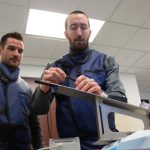How We Incorporate 3D Printing into our Process
The use of 3D printing has become widespread in the last few years.
In fact, 3D printing has become so convenient, people are able to print all sorts of things, including phone stands, household tools and replacement parts for around the house. There is even talk about using 3D printers to create organs and other body parts.
It may surprise you to learn that the medical device industry has benefitted from 3D printing since the 1990s, when medical professionals would use 3D-printed tooth implants. The first 3D-printed prosthetic leg was used in 2008, and since, the technology has become widely used in the medical industry to aid with research, surgery and treatment.
Nextern works to stay up-to-date in contemporary medical technology. Our five industrial 3D printers expedite the research, development and manufacturing process for our partners to improve patient outcomes.
3D Printing is the New Standard Toolkit for Engineering
Nearly all modern medical device manufacturers utilize 3D printing technology. At Nextern, we have two FDM printers and 3 SLA printers, including one large format SLA printer. The FDM printer is an affordable and easy way to print large and durable products. SLA printers are ideal for printing smaller prototypes, or for those projects with more defined details.
Due to the varying needs of manufacturing medical devices, we work with a full library of SLA and FDM materials. This allows us to more easily design and print many different projects and devices without delay.
3D Printing Optimizes the Process of our Services
At Nextern, we pride ourselves in the streamlined and thorough process of getting new medical technology onto the market. Our 3D printing has helped make that process even easier and faster. For example, early stage design concepts can be brought to production by printing functional and aesthetic prototypes more quickly. By getting the prototype in our hands sooner, we can locate areas of improvement for the product. This iterative process helps design and mold prototypes in real life rather than in CAD software, saving time and energy in the process.
Once a body-worn device is ready for beta testing, we make use of the organic shapes and forms 3D printers are capable of. Doing so allows us to get devices out faster for testing, and Nextern’s beta users often use devices that are 3D printed. This also saves time, money and energy by avoiding the process of injection molding.
3D Printing is the New Approach to Medical Technology
Engineering and manufacturing modern medical technology requires teams of professionals working hard to perfect the product, which is why 3D printing has become the new standard practice for Nextern’s process. Custom tools and fixtures allow us to create myriad test products with little effort. 3D printing informs our research and development process and enhances the aesthetics and application of testing prototypes. Sometimes we even use 3D printing for practical applications, too, such as creating a heart model. All of this works together to optimize the process of getting new medical technology in the hands of those who will benefit most.
Partner with Nextern
30 years ago, the thought of printing a prosthetic leg wouldn’t have even crossed anyone’s mind. Our modern medical technology is made possible by technology such as 3D printing.
Whether you are still fine-tuning your next big idea, or if you are looking to mass-produce your new medical device product, Nextern’s 3D printing technology and collaborative manufacturing and engineering teams can help bring your ideas to life. Learn more about Nextern’s planning and development process, or contact us to get started on your next big project.







